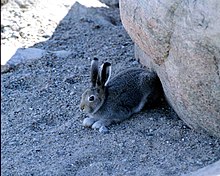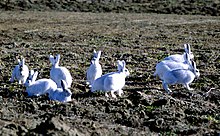Arctic hare
| Arctic hare | ||||||||||||
|---|---|---|---|---|---|---|---|---|---|---|---|---|

Arctic hare ( Lepus arcticus ) |
||||||||||||
| Systematics | ||||||||||||
|
||||||||||||
| Scientific name | ||||||||||||
| Lepus arcticus | ||||||||||||
| Ross , 1819 |
The polar hare ( Lepus arcticus ) is one of the real hares . For a long time it was considered a subspecies of the mountain hare ( Lepus timidus ), but it is now viewed as a separate species. It occurs in the arctic part of Canada and on Greenland .
features
Arctic hares are particularly adapted to the conditions in the northern polar regions . There is no difference between males and females. In winter the animals have a white fur, only the tips of their ears remain black. The summer coat color differs depending on the location of the habitat: While arctic hares native to the high Arctic ( Ellesmere Island and Greenland ) keep their white fur all year round, conspecifics living in southern Arctic areas are subject to a seasonal color change and wear a blue-gray Hide; only the tail remains white. Various gradations can be observed in the areas in between. Basically, the underfur is dense and gray.
Adult arctic hares weigh between 2.5 and 6.8 kilograms, with those living in the north being the larger on average. Their length is between 56 and 63 centimeters. The paws, especially the front paws, are relatively long and curved and make excellent tools for digging for plants under hard snow. In addition, the animals have pronounced incisors with which they also dig for food; these incisors vary in length depending on the local conditions.
Distribution area and habitat


The occurrence extends to the tundra areas of Greenland and Northern Canada up to an altitude of 900 meters. The arctic hare can be found in mountainous areas as well as in lowlands, but prefers areas that allow plant growth in the short arctic summers, are not too snowy in winter and allow digging for plants.
Arctic hares, 34,000 years old, have been found on Banks Island ( Northwest Territories , Canada). 12,000 year old remains have been discovered in Greenland.
Way of life
Reproduction

The breeding time of polar hares depends on the growth and regression of the male gonads . These increase around the beginning of April and decrease again around mid-September. The mating takes place accordingly in April and May. The unborn cubs have developed fully by the end of May and then, depending on the local situation, are born in late May, June or July - on the mainland until mid-June, on Ellesmere Island and in North Greenland only towards End of June. The female mammary glands are ready until the end of August, so that a second litter appears possible in the same summer.
Mating takes place in small separate areas. It is part of the mating behavior that the male bites the neck and shoulder of the female, which can lead to bleeding. Usually the male leaves the female after the young are born. It can then turn to another female.
The litter consists of 2 to 8 boys. The birth nest, well camouflaged in rock depressions or between undergrowth, consists of compressed grass or moss, padded with dry plant parts and the mother's fur hair. In the first three days after the birth, the mother does not leave the young alone. After that, the boys are already able to protect themselves by hiding in danger and appearing like a piece of rock through silent, motionless behavior. After 2 to 3 weeks, the young become largely independent of the mother and only go to her to suckle. In the first month the young gain about 50 grams per day; after about 2 months they are weaned. In September the boys reached adult size. They are sexually mature after a year.
behavior

Most of the time, polar hares are solitary animals, but at times they also form groups of up to 300 animals, some of which are always particularly vigilant and warn of danger. During the mating season, the groups disperse.
Innate and acquired behaviors enable them to be active all year round and also to survive the harsh arctic winter. The best possible ratio of body surface area to body size and a fur that protects against the cold ensure that a normal body temperature is maintained even with low energy expenditure. At particularly low degrees of cold, the animals huddle together and thus receive additional protection from the cold.
Locomotion
Arctic hares are very nimble and can reach speeds of up to 65 kilometers per hour. On the run, the animals living in the south adopt a four-footed gait; the high arctic animals begin to run only on their hind legs and only then fall into a four-footed gait; if they are followed closely, they resume bipedal pace.
They are able to swim across narrow rivers.
activities
They are crepuscular and nocturnal ( naturally also diurnal in areas with midnight sun ). When looking for food, they move in a relatively small radius and follow tried and tested habits.
When fighting, the animals box and scratch each other; they also grab one another with their paws, but they don't bite. There is no ranking according to gender.
nutrition
The main food source for arctic hares are lignified plants. They eat moss, lichens, leaf and flower buds, flowers, berries, grasses, various types of plants and even meat from hunters' traps.
Relationship of polar hares to other living things
Arctic hares are not pests for humans, and they also have no threatening influence on the life of other animal species. Young animals serve as prey: weasels , arctic foxes , snowy owls , peregrine and gyr falcons and hawks ; the adult animals, on the other hand, are so nimble and agile that they can usually escape these predators. People sometimes use their meat as food and their fur as clothing.
literature
- AWF Banfield: The Mammals of Canada. University of Toronto Press, Toronto / Buffalo 1974. 2nd edition 1977, ISBN 0-8020-2137-9 .
- Troy L. Best , Travis Hill Henry: Mammalian Species . Number 457. The American Society of Mammalogists, 1994, ISSN 0076-3519 .
Web links
- Museum of Zoology (University of Michigan)
- Lepus arcticus in the endangered Red List species the IUCN 2006. Posted by: Lagomorph Specialist Group, 1996. Retrieved on 6 May, 2006.
